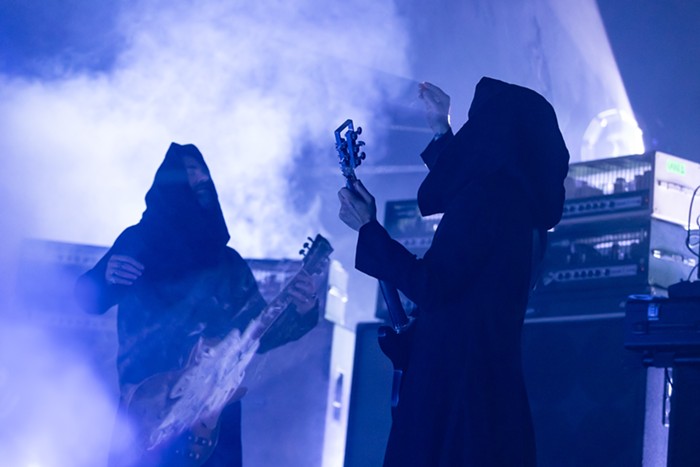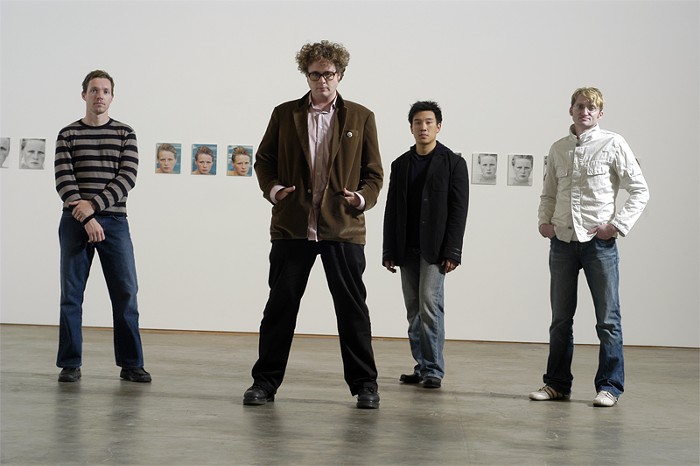OM
Conference of the Birds
(Holy Mountain)


 1/2
1/2
All aboard the stoner-rock express. Which is a flip way of alluding to Om's transporting qualities as well as bassist-vocalist Al Cisneros's and drummer Chris Hakius's rep as two-thirds of the innovating, all-the-bong-hits-all-the-time metal cultists Sleep. But enough—get past old Sleep songs like "Dopesmoker," and with one album to Om's name, 2004's Variations on a Theme, and consider their reverence for the mind-altering qualities of mantras, the hypnotic pleasures of their at-times-delicate but inevitably overwhelming riffs, and the spiritual preoccupations suffusing their majestic new release, Conference of the Birds.
True to the discipline established with Sleep's 52-minute, single-song Jerusalem, Conference divides its attentions between two 15-minute-plus pieces. The first, "At Giza," starts softly and seductively with cymbal shimmer and a prayer to the sun, eventually coming to a crunching climax with allusions to seraphim and cremations. Sweet. The more martial "Flight of the Eagle" returns to harder, heavier territory akin to fellow Bay Area metallists Neurosis. But there's an alluring purity of concept and form that distinguishes Om: Here and on "At Giza," birds might be seen as metaphors for the spirit. Still, Om can't be relegated simply to a soft-skulled New Age peanut gallery. The occasionally subdued production by longtime engineer Billy Anderson—dotted with subtle edits and effects—continues to be offset by Hakius's almost frisky beat and Cisernos's fuzzed, low-end tracings. The bass tone may be several steps closer to the gods, but don't forget that this same track surfaced on the recent Hot Chick Hot Rod Stoner BBQ DVD. That combination of biker-boogie grit and uncompromising, ascetic intensity keeps Om in the here and now. KIMBERLY CHUN
JON AUER
Songs from the Year of Our Demise
(Pattern 25)

 1/2
1/2
It's not the '90s anymore. Which is too bad for Jon Auer, who with the Posies successfully rode the cresting power-pop wave of that sunny decade. Since the band's abortive break-up in 1998 (they got back together in 2005 to record Every Kind of Light), Auer has released an EP and formed part of a reborn Big Star, but he describes Songs from the Year of Our Demise, his first solo full-length, as an "all-consuming, important-to-me, it's-my-baby type of affair." It shows. On the album, Auer struggles so valiantly to recapitulate his tale of love lost and gained, that it makes for sometimes awkward listening. In 15 songs, Auer repeatedly runs an emotional gauntlet from bitter resignation to wistful optimism as though he's on a penitential obstacle course. It's all a bit exhausting. There are some decent tunes, with echoes of the Kinks ("Six Feet Under"), Matthew Sweet ("Josephine"), and Freedy Johnston ("Wicked World"), but even the better tracks leave me feeling that Auer could do better if he just stopped trying so hard. Songs from the Year of Our Demise is such a labor of love that at times it makes love seem laborious. It's too bad, because the success of the album depends on our participation in Auer's catharsis. Near the end of the album, he sings plaintively, "I'll believe if you'll believe," and in 1991 I almost could have had faith in this sacrament of sincerity; in 2006, though, I just can't do it. CHRIS McCANN
Auer plays a CD-release party on Thurs April 27, Sunset Tavern, 9 pm, $7.
WIZARDZZ
Hidden City of Taurmond
(Load)



The promo sheet for Hidden City of Taurmond references, among other things, John Carpenter's 1981 soundtrack to the film Escape from New York. And while it's tempting to think of Taurmond's prog-ish, synthesizer/drum trajectory as its own soundtrack to a world where, say, Manhattan is a heavily guarded maximum-security prison; world peace hangs in the balance of a tape cassette inside a briefcase that's hand-cuffed to the president of the United States; Isaac Hayes is a ruthless underlord instead of a Scientology martyr; and Kurt Russell really is badass, that reference only tells part of the story. For starters, Wizardzz are Lightning Bolt's Brian Gibson on drums and Rich Porter of Bug Sized Mind on synthesizers. Granted, at times the Carpenter reference is spot-on. Synth-led songs like "Sailship" and "Rest at the Gate," where Gibson's percussion is held to a minimum of sparsely distributed rim tapping and cymbal teasing, fit the bill. But when Gibson leads with his formidable drum churn, the whole package is far too aurally intrusive to leave any room for dialogue (see: "The Bubiliad Woods of Taurmond" or "Mimi Vivian Sunrise [Live].") With these cuts, it's clear Gibson has taken a few cues from his Lightning Bolt bandmate Brian Chippendale. Despite a few relatively busy interludes—one of which, "Glimpse of the Hidden City," features bagpipe effects—Porter's synthesizer noodling stays fairly innocuous, adopting different effects to provide variation throughout an album that bares no hit singles, but rather a fluid and cohesive whole. GRANT BRISSEY
ONRY OZZBORN
In Between
(Camobear)




Sorry to Onry Ozzborn and Seattle for having slept on one of the best CDs to come out last year (it was released in November), but as they say, better late than never. In Between, which is Onry Ozzborn's third full-length solo effort, is by far his most accomplished. And that's not saying anything bad about his previous solo work, or his work with Oldominion and Grayskul—all of it stands as solid hiphop. In Between, however, takes the next step forward and we find Onry in a magical place where he has complete control of his raps and musical ideas. The CD is not bloated (12 tracks) and boasts guest performances by underground stars like Aceyalone and Non Phixion. The high range of the CD's dark, gothic hiphop has two pronounced peaks: "Part 3" and "Part 4." "Part 3" features triphop-ish vocals by Toni Hill, and "Part 4" features dream-drunk raps by Silent Lambs Project's Blak and Oldominion's Nyqwil. Both tracks were produced by Mr. Hill and have a beat that is made of pure concrete and a sample of a big brass arrangement that transforms Seattle's ordinary street scenes into the dramatic terms of a Hollywood blockbuster scored by Bernard Herrmann. Listen to "Part 4" and look out the window at the heavy construction that's rapidly expanding and extending downtown Seattle—soon, very soon, we will be in a very big city. CHARLES MUDEDE
STARLIGHT MINTS
Drowaton
(Barsuk)



It's pretty safe to assume that you're gonna get a disc full of quality indie pop when you pick up any Barsuk Records release. With a roster boasting acts like Aqueduct, Mates of State, Smoosh, and Nada Surf, it's sort of a no-brainer that the Seattle label is gonna hit a home run in the genre. But with each release of that, dare I say, predictable sound, comes each band's trademark spin on it, which is what makes Barsuk's catalog more varied than you might expect. And if there's any Barsuk outfit that delivers a bushel of the unexpected, it's the zany and fun Starlight Mints. The Mints go beyond mere pop music and demonstrate a flare for the dramatic in their compositions that comes off more like short stories than they do typical songs. Implementing bells, strings, horns, piano, and a plethora of synthesizer noises and sound effects, the Starlight Mints' latest release, Drowaton, is a feel-good record that's more involving and sophisticated than any simple pop disc could ever be. The album isn't content simply to make you smile with upbeat rhythms; Starlight Mints' ballsy attack, combined with their approachable and theatrical sound, reminds you that some artists are still taking chances—and succeeding. MEGAN SELING
VARIOUS ARTISTS
Big Apple Rappin'
(Soul Jazz)



TOM MOULTON
A Tom Moulton Mix
(Soul Jazz)


 1/2
1/2
With his announcement in the middle of the Oscars, "Martin Scorsese: 0, Three Six Mafia: 1," Jon Stewart unwittingly marked a new turning point in hiphop. It's not the first important date in the history of the form, though, but then neither is that first summer block party thrown by Kool Herc nor when Grandmaster Flash learned to flip the fader between his turntables. Instead July 14, 1977, (when New York suffered a rolling blackout) remains ground zero for hiphop, with subsequent looting bringing previously unaffordable turntables to the ghetto. Almost overnight, everyone was a DJ.
The two-disc Big Apple Rappin' traces what the stolen merch did to transform the street scene between Sugarhill Gang's "Rapper's Delight" and Run-D.M.C.'s "Sucker MC's." The nascent art form is here in all its endearing early quirks: endless disco loops tether the rambling rhymes (only General Echo's "Rapping Dub Style" clocks in under five minutes) with scant regard for measures and bars. Pre-Rakim, breath control and lyrical coherence aren't yet a requirement, resulting in breathlessness, inanity, or constant tag teaming. Spoonie Gee's "Spoonin' Rap" liberally doses his notebook rhymes in reverb and delay, while Spyder-D's title track could double as Gotham's tour-bus guide. The set's highlight no doubt is Brother D & Collective Effort's "How We Gonna Make the Black Nation Rise." Over a Michael Jackson joint, Brother D brings together militant political thought, sistas on the mic, plus a healthy fear of a police state.
While P. Diddy claimed to invent the remix, that honor instead goes to Tom Moulton. An A&R man in the '60s, Moulton gave up the biz for a modeling career, only to be drawn into the blossoming discotheque scene, both in Manhattan as well as out on the more flamboyant Fire Island. Realizing that DJs were frantic with switching out 45s, Moulton began to mash sides together on tape, creating nonstop mixes. Soon after, he pressed his connections to access instrumental master tapes, and—using the breakdown of gospel sermons as his model—Moulton staved off musical climax as he rebuilt sides in his image.
Years before Herc, Bambaataa, and Flash began isolating the drum breaks, Moulton was already keying in on his favorite parts (often the elastic bass line and stomping backbeat) and restructuring them around that nugget. Sixteen such edits are collected on A Tom Moulton Mix, sprawling across two discs. Take the example of Eddie Kendricks's diesel "Keep on Truckin'" (present here as a previously unreleased 11-minute epic). The bass-heavy opening fanfare chugs along a good two minutes before the ex-Temptation's croon comes in, then the song takes nearly every back road possible: through the congas, horns, and vibraphones, extending the pop song to near-tantric lengths. Under Moulton, almost any component of a song could mutate and overtake the original, from the Indian toms on BT Express's "Peace Pipe" and MFSB's orchestral opulence on "Love Is the Message" right down to the tangy banjo from Al Downing's "I'll Be Holding On." Such expansions remain prescient, transcendent, and, well, timeless. ANDY BETA
PARENTHETICAL GIRLS
(((GRRRLS)))
(Slender Means Society)



The history of (((GRRRLS))), the debut album from this Portland duo, reads like a word problem plucked from the Permutations and Combinations unit of a middle-school math text. In 2002, boyhood chums Jeremy Cooper and former Stranger staffer Zac Pennington committed a clutch of home recordings—fashioned from disparate instruments like bass synthesizer, glockenspiel, and detuned guitar—onto low-bias cassettes. After many months of neglect, the source materials were bumped up to digital, and handed over to Jherek Bischoff (the Dead Science) and Jamie Stewart (Xiu Xiu), who mixed completely different incarnations of the seven-song set that became (((GRRRLS))). Dubbed the "X" and "O" versions, they were released together on one limited-edition LP in 2004. This new CD reissue includes both; slap it in a conventional CD player, you get "O," while "X" pops up only on your computer.
What the various (((GRRRLS))) all share is an audible love for playful experimentation, anchored by a firm grasp of pop fundamentals; with its jingle bells and disquieting chortling, "Tuba For Soprano" could pass for a Martian Christmas carol. The creepy, feminine "sha-la-las" wafting through the petal-soft cacophony of "C-86 Is Killing My Life" suggest Sonic Youth after ingesting top-shelf Ecstasy, or post-punk luminaries Young Marble Giants at their giddiest. Of the two versions, Bischoff's "O" is marginally more dissonant, but due to their scant 23-minutes duration, one can sample both back-to-back in less time than it takes to listen to most uninterrupted long-players—and with equally enjoyable results. KURT B. REIGHLEY
THE FLAMING LIPS
At War with the Mystics
(Warner Bros.)

In Sunday morning's wee hours, Oregon Public Broadcasting shows Austin City Limits, which usually affects me like 10 Lunestas and a bottle of Carlo Rossi—but a few weeks ago, the Flaming Lips showed up on ACL, and it was amazing. Wayne Coyne and company were onstage with giant balloons and confetti and really powerful flashlights and a gaggle of people in creepy animal costumes—and the Lips were just tearing through shit. They called up Cat Power and she played Black Sabbath's "War Pigs" with Coyne—who poured fake blood on his face and wore an American flag as a cape. After that, one of the Lips' saxophonist fathers tottered out and everyone did "Somewhere Over the Rainbow"—a song that was written for the singular purpose of making anyone who hears it claw his own eyes out, but here it was excellent.
They followed "Rainbow" with an amped-up version of "She Don't Use Jelly" and an even more amped-up "Yoshimi Battles the Pink Robots, Part I," and it was all this near-perfect synthesis of emotion and spectacle and music. Sure, it was goofy and aimless, but the fun was so contagious that I thought, "Okay, even though Yoshimi only had three good songs on it, maybe their new album can bring it like this." It doesn't. At War with the Mystics is aimless, goofy, and not much fun; instead, there are vaguely political lyrics that carry about as much weight as a whiny trustifarian on indymedia.org, a few ephemeral hooks, and some rambling soundscapes that'd be more at home in Trey Anastasio's barn. It's all a little boring—and in the light of that Austin City Limits, more than a little saddening. ERIK HENRIKSEN
WHITE RAINBOW
Box
(Marriage)


 1/2
1/2
I used to think White Rainbow was a "gray rainy-day band," a good soundtrack to what you're probably seeing out your window at this very minute. That is, if you're around a window, and in the Northwest as you read this. If you've somehow time-warped into a summer afternoon in, say, Big Sur or Santa Cruz, you might be livin' closer to this box set's sunny, mellow, five-hour, 37-track run.
I listened to all five hours in one sitting, and the fact that I didn't stab myself in the heart with a pencil is a good sign. Five hours of most any music is heavy, but this was no sweat, a full-on ambient, chill brain massage. Which is not to say Adam Forkner's White Rainbow is only good as background music; you could get all headphoned out on this, stare off into the cosmos, and get lost in all the ebbing and flowing and amniotic puddles.
Favorite moment: I've always dug the rhythms made by my dishwasher and dryer and thought they'd play well together in an all-appliance band. Problem is, they're on different floors. Here, with "6-12-05 Holy Fuck," it sounds like Forkner's house has 'em both on one level (and has somehow magically dropped Airwolf's chopper-blade noise into the mix; even better).
Now, if you do sit down and give this set some decent attention, you'll see there's a lot more going on than pretty ambience. Shit gets dissonant too; weird squelches blurt out, something that sounds like a bird being strangled yelps while a guitar loop flops over like a catfish dragged up on dry land. And there's some wild low-end action too, thick, deep bass tones that rattle your teeth and stir up your guts (kinda like IMAX bass noise rumbling through your seat while you watch The Majesty of the Bottlenose Dolphin or some shit).
A lot of this record, though, is hard to pin down. It comes in abstractions, songs that are more sketches than full tracks, impressionist freak-outs, the kind of musical nonmusic that's too new and uncharted to really break down and get rock critical about. (Here are a few notes I took on things the music reminded me of: ice melting, puking on the sly so your friends don't hear you, echoes in empty rooms, food digesting, crumpled paper uncrinkling, etc.).
If you get a copy of this box set, make sure you at least try to listen to it consecutively. It may sound like a big undertaking, but it really isn't. It might actually be good for you to slow the fuck down a while and go off in your head for five hours. Consider it spring break; you may not get drunk and laid, but R&R is R&R. ADAM GNADE
BIRD SHOW
Lightning Ghost
(Kranky)


 1/2
1/2
KEITH FULLERTON WHITMAN
Lisbon
(Kranky)



For 13 years, Kranky Records has been releasing ambient music that often goes beyond the sort that makes for good bongwater-changing soundtracks—not that there's anything wrong with that. While you could light up to Bird Show's second album, Lightning Ghost, you'd probably miss the clever songwriting while basking in a haze.
Town and Country's Ben Vida is Bird Show, and the lo-fi bedroom music he makes under that name sounds like solo Syd Barrett jamming in the African bush. Guitars mimic mbiras and tinny tribal percussion clanks hypnotically behind a bed of electro-acoustic drones as Vida's double-tracked but not-always-quite-synched voice intones tales from the subconscious. His distracted, spacey singing gives the songs their "hooks," but only in as much that we recognize familiar patterns of human speech; the music is resolutely cyclical or free, not based on chord changes. Lightning Ghost's nine songs invoke a ritualistic late-night ceremony with a freak-folk shaman who knows deeply about the structures and conceits of traditional singer-songwriting—so much so that he never has to rely on them.
Keith Fullerton Whitman (who also records phenomenal experimental-electronic music as Hrvatski) long ago dispensed with typical structures, too, though there is often a sense of composition in his long-form drones, even if he is improvising. The live to hard-disk Lisbon is listed as an EP, but the one song it contains lasts for 41 minutes and 41 seconds. The music is built out of warm guitar and synth ambience that has been stretched, pinched, chopped up and reassembled to resemble field recordings inside a heavy-machinery factory. Bright, beautiful, and inviting harmonics develop out of overlapping cloudbursts of sound, and when listened to on headphones, Lisbon acts like a sine-wave brain massage. In other words, change-the-bongwater music. CHRISTOPHER PORTER




















